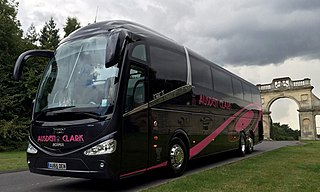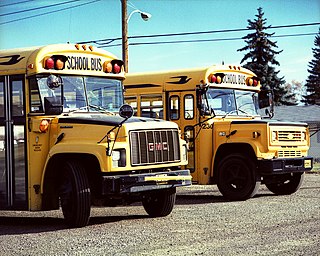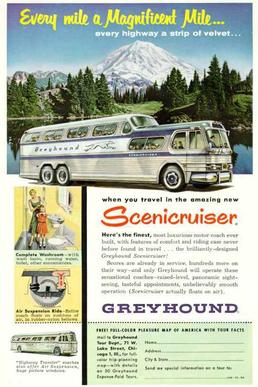
A coach is a type of bus built for longer-distance service, in contrast to transit buses that are typically used within a single metropolitan region. Often used for touring, intercity, and international bus service, coaches are also used for private charter for various purposes. Coaches are also related and fall under a specific category/type of RVs.

The GMC Envoy is a mid-size SUV manufactured and marketed by General Motors for the 1998 to 2009 model years over two generations. Adopting a nameplate used by GM Canada, the Envoy was a rebadged variant of the Chevrolet TrailBlazer, Oldsmobile Bravada, Buick Rainier, Isuzu Ascender, and Saab 9-7X.

The GMC Motorhome is a recreational vehicle that was manufactured by the GMC Truck & Coach Division of General Motors for model years 1973–1978 in Pontiac, Michigan, USA — as the only complete motorhome built by a major auto/truck manufacturer. Manufactured in 23 and 26 ft lengths, the design was noted for its front-wheel drive and its low profile, fully integrated body.

Greyhound Canada Transportation ULC began as a local British Columbia bus line in the early 1920s, expanded across most of Canada, and became a subsidiary of the US Greyhound in 1940.
The Yellow Coach Manufacturing Company was an early manufacturer of passenger buses in the United States. Between 1923 and 1943, Yellow Coach built transit buses, electric-powered trolley buses, and parlor coaches.
NJ Transit Bus Operations' and companies leasing buses from NJ Transit use various models of buses between 25 and 60 feet in length to provide service within the state of New Jersey. The lists and rosters below list current and past buses purchased new or inherited by NJ Transit for heavy duty fixed-route service.

The Chevrolet and GMC B series was a series of cowled chassis that were produced by General Motors. Produced across three generations from 1966 to 2003, the model line was a variant of medium-duty trucks marketed under the Chevrolet and GMC nameplates. Initially derived from the medium-duty C/K series, later examples were derived from the GMT530 architecture.

The Eagle was a make of motor coach with a long and interesting history. During a period of over four decades, some 8,000 Eagle coaches were built in four countries on two continents. The coaches were a common sight on American highways and were strongly associated with Continental Trailways for over three decades.

The GM New Look bus is a municipal transit bus that was introduced in 1959 by the Truck and Coach Division of General Motors to replace the company's previous coach, retroactively known as the GM "old-look" transit bus.

The Rapid Transit Series (RTS) city bus is a long-running series of transit buses that was originally manufactured by GMC Truck and Coach Division during 1977, in Pontiac, Michigan. First produced in 1977, the RTS was GMC's offering of an Advanced Design Bus design (the other entry was the Grumman 870 by competitor Flxible) and is the descendant of GMC's prototype for the U.S. Department of Transportation's Transbus project. The RTS is notable for its then-futuristic styling featuring automobile-like curved body and window panels; the Advanced Design Buses were meant to be an interim solution between the high-floor transit buses that preceded them, such as the GMC New Look (which had a curved windshield, but flat side glass and body panels), and modern low-floor buses that would facilitate passenger boarding and accessibility. Most current buses are now made by specialized coach manufacturers with flat sides and windows.

The GMC PD-4501 Scenicruiser, manufactured by General Motors (GM) for Greyhound Lines, Inc., was a three-axle monocoque two-level coach that Greyhound used from July 1954 into the mid-1970s. 1001 were made between 1954 and 1956.

The GM "old-look" transit bus was a transit bus that was introduced in 1940 by Yellow Coach beginning with the production of the model TG-3201 bus. Yellow Coach was an early bus builder that was partially owned by General Motors (GM) before being purchased outright in 1943 and folded into the GM Truck Division to form the GM Truck & Coach Division. The Yellow Coach badge gave way to the GM nameplate in 1944. Production of most "old-look" models was stopped upon the release of the GM New-Look bus in 1959, however some smaller "old-look" models continued to be built until 1969. Approximately 38,000 "old-look" buses were built during the 29-year production run. The "old-look" name is an unofficial retronym applied to this series of GM buses after the release of the GM New-Look series.

The Blue Bird All American is a series of buses produced by American school bus manufacturer Blue Bird Corporation since 1948. Originally developed as a yellow school bus, versions of the All American have been designed for a wide variety of applications, ranging from the Blue Bird Wanderlodge luxury motorhome to buses for law enforcement use.

The Crown Supercoach is a bus that was constructed and marketed by Crown Coach Corporation from 1948 to 1991. While most examples were sold as yellow school buses, the Supercoach formed the basis for motorcoaches and other specialty vehicles using the same body and chassis. While technically available outside of the West Coast, nearly all Crown school buses were sold in Washington state, Oregon and California.

The Chevrolet Van or Chevy Van is a range of vans that was manufactured by General Motors from the 1964 to 1996 model years. Introduced as the successor for the rear-engine Corvair Corvan/Greenbrier, the model line also replaced the panel van configuration of the Chevrolet Suburban. The vehicle was sold both in passenger van and cargo van configurations as well as a cutaway van chassis that served as the basis for a variety of custom applications.

The GM PD-4103 was a single-decker coach built by GMC, in the United States, in 1951 and 1952. It was a 37- or 41-passenger Parlor-series highway coach and was an improved version of the earlier PD-4102 "transition" model. A total of 1501 were built, 900 in 1951 and 600 in 1952, plus one that was converted by GMC from a PD-4102. In early 1953, this model was replaced by the groundbreaking PD-4104 "Highway Traveler". The PD-4103 competed directly with, and surpassed in sales, a similar model from ACF-Brill Corporation, the IC41.

GX-1 was the first post-WWII concept bus from Greyhound that evolved into the Scenicruiser PD-4501.
The GX-2 was a prototype bus built for Greyhound that would eventually be developed into the Scenicruiser. It began in mid-1948 as a 35-foot design, but, in part, to accommodate more passengers, Greyhouse President Orville Caesar directed his engineering department, which had obtained from GM a PD-3751, to add five feet in length to the upper deck. After Greyhound's initial experiences with GX-1, the 50-seat double-decked bus, Caesar decided that the next prototype would be a deck-and-a-half style. This decision resulted in the iconic silhouette of the Scenicruiser.

The Flyer 700/800/900 series were a series of transit buses built in three generations by Western Flyer and its successors Flyer Industries and New Flyer, of Canada, between 1967 and 1987. Except for brief overlap during transition from one generation to the next, they were not in production concurrently. All individual model designations included a prefix of either D, for diesel propulsion, or E, for electrically powered trolleybuses, with the first digit indicating the generation and the last digit indicating a variant within the generation. The introductory model was the D700, originally released in 1967 for the Canadian transit market, and the last series group to be produced, D900, was discontinued in 1987. Flyer had become New Flyer only the year before, in 1986.

The second generation of the C/K series is a range of trucks that was manufactured by General Motors. Marketed by both the Chevrolet and GMC divisions from the 1967 to 1972 model years, this generation was given the "Action Line" moniker by General Motors. As with its predecessor, the second generation C/K included full-size pickup trucks, chassis cab trucks, and medium-duty commercial trucks.



















